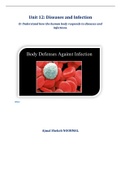Essay
BTEC Applied Science Unit 12 Assignment D
- Course
- Institution
This is the last assignment for Unit 12 in BTEC Applied Science Course. It was awarded DISTINCTION. Its format is Word and is referenced in Vancouver style. Good luck with your coursework
[Show more]



